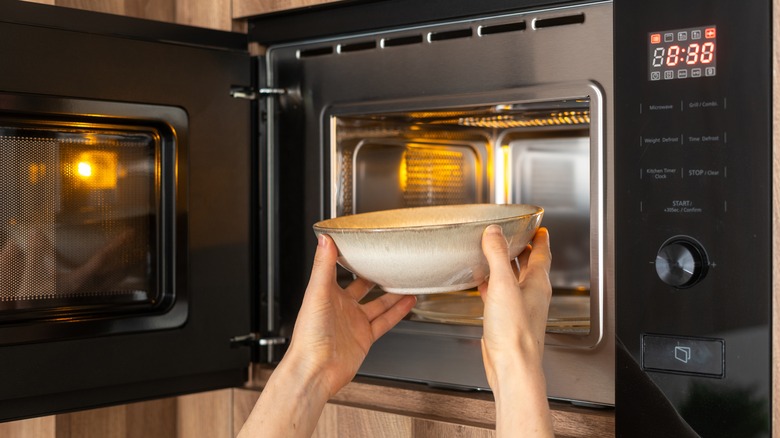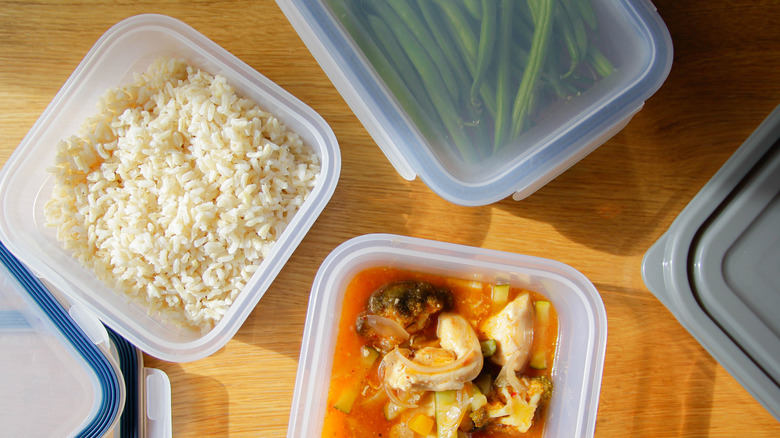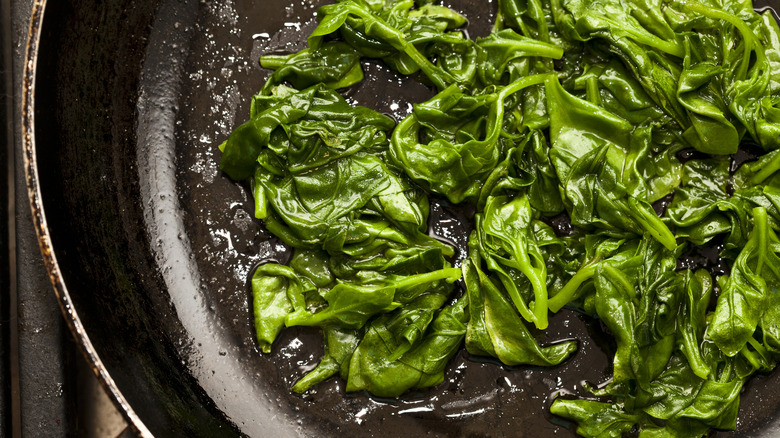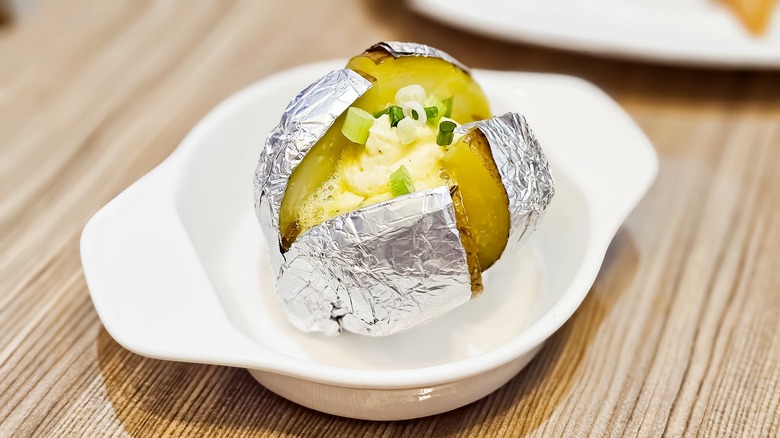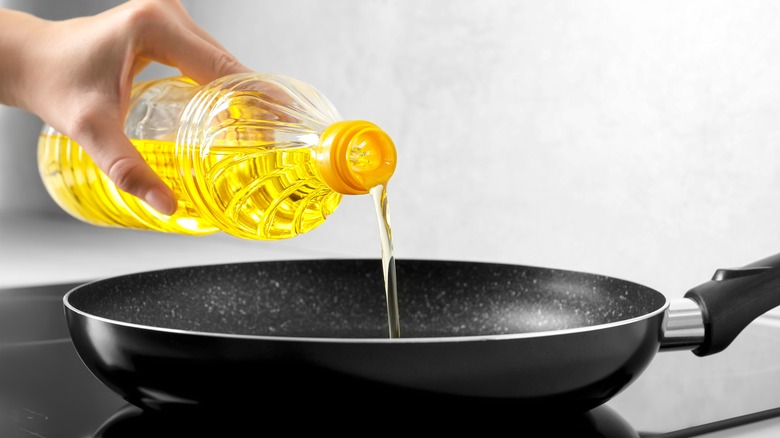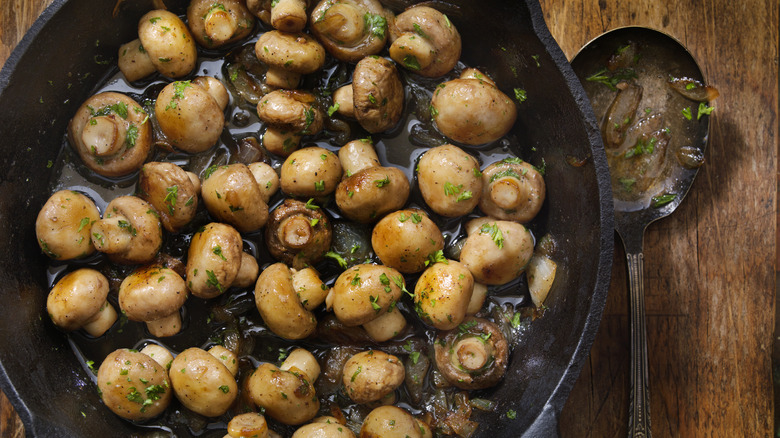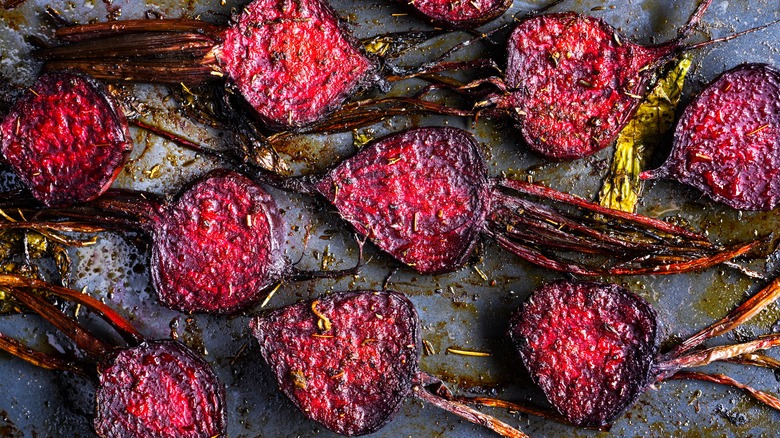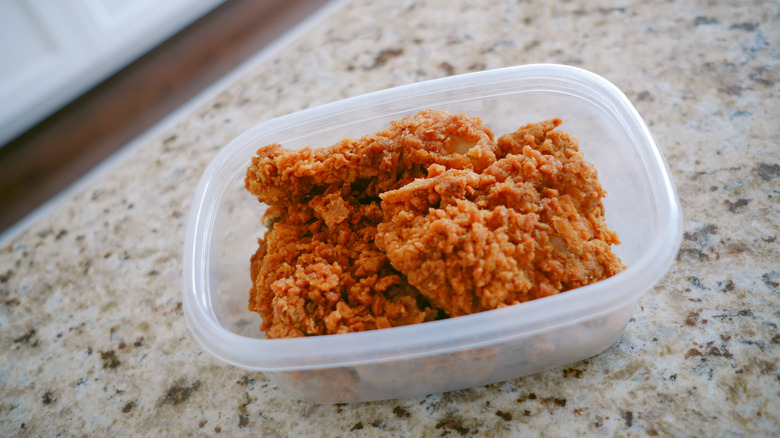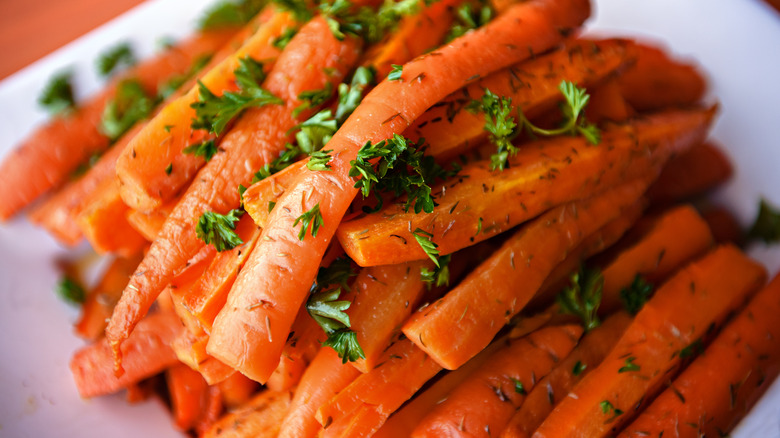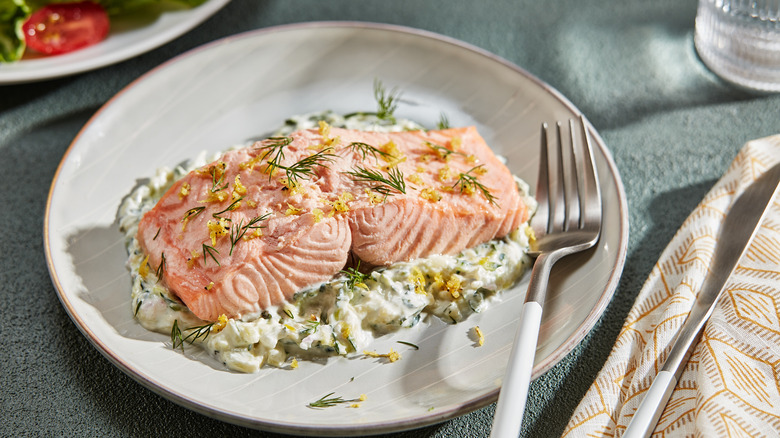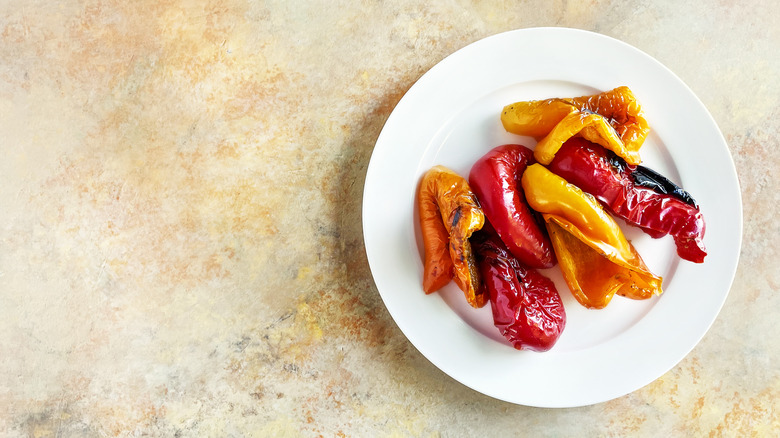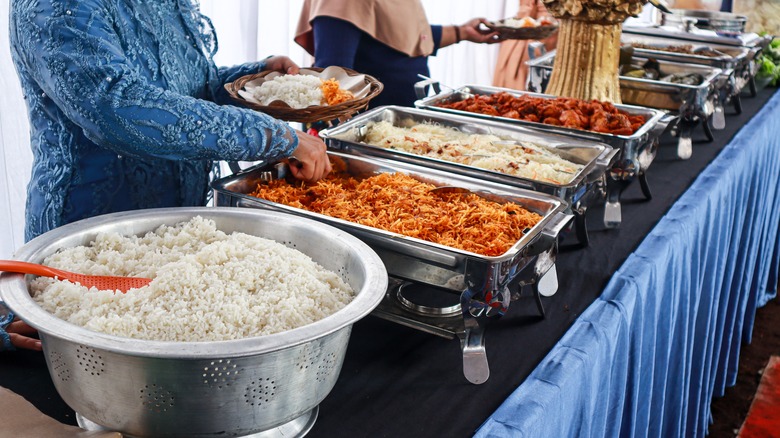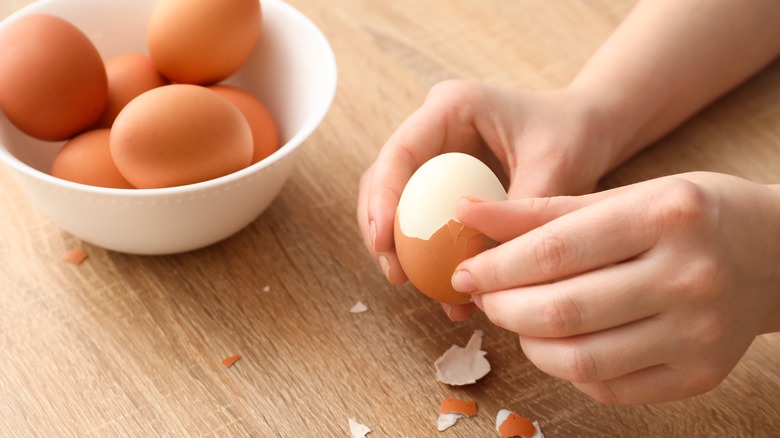12 Foods You Should Think Twice About Reheating
Leftovers are often a godsend. Too busy on a hectic Monday to put anything worthwhile on the dinner table? Your weekend leftovers are here to the rescue. Hankering for a midnight snack? Last night's leftovers are calling your name. Stumped for cooking inspiration? Turn those leftovers into a brand-new dish. But, while leftovers can be both convenient and tasty — and some foods are even tastier after a day or two in the fridge — not all leftovers are worth keeping. Or, at the very least, you should think carefully when reheating them.
Some foods just don't reheat well (looking at you, eggs), but others can be downright dangerous if you don't reheat them the right way (and, even if you do, you still might not save yourself from nasty food poisoning). We're talking leftovers that you shouldn't just sling into the microwave for a few minutes and then eat around the cold spots, like you might be in the habit of doing. To help you keep your belly and taste buds happy, here are some of the foods you should never reheat without a fair degree of caution.
Rice
Rice is a favorite leftover, whether you've baked it into a cheesy casserole, or you ordered Chinese takeout and now you have an abundance of white or fried rice. However, reheated rice can cause food poisoning, no matter how carefully you reheat your leftovers. In fact, this leftover is so iffy that the nasty symptoms that can follow eating it have gained the name "reheated rice syndrome."
It's all because rice is one of the handful of starchy foods that can harbor a bacteria known as Bacillus cereus. The bacteria is heat-resistant, so no amount of microwaving or time spent bubbling in a sauce in the oven will kill it, once it forms. So how does it form and how can you avoid it?
The bacteria lives in the rice and is relatively benign at first, but then, if the cooked rice sits in the "danger zone" of 40 to 140 F, the bacteria can begin to spread and multiply. As it does, it produces toxins that can make you ill. So, let's say you cook some rice, eat it, and are fine, but then you accidentally let the cooked rice cool on the stove for a few hours. You put it in the fridge, but now it's too late. The bacteria has formed and the leftovers can now make you sick. The key to avoiding it is to cool and store your leftover rice quickly.
Spinach
While reheating leftover spinach might not give you food poisoning, it could increase your risk of cancer. Spinach is high in nitrates and, under the right circumstances, nitrates form nitrosamines, a chemical known to increase cancer risk. Higher nitrate levels have also been connected to nutrient deficiencies and increased risk of kidney stones.
Unfortunately, the initial cooking process and then reheating spinach can both increase the amount of nitrates in the food, as can long storage times. A study published in the scholarly journal Foods recommends not storing boiled spinach for more than 12 hours at room temperature, if you want to avoid a "direct nitrate safety risk" and "adverse health effects."
The key to avoiding these leftover spinach side-effects, according to Wageningen University & Research, is to limit the amount of heat you expose your spinach to, including both cooking times and overall high heat, as well as to always store leftover spinach properly, in the refrigerator.
Potatoes
Baking a potato is almost as easy as reheating leftovers. Poke a few holes in the middle, wrap the potato in foil, and pop it in the oven or on the grill. Just don't toss them (or leftovers) into the fridge, foil and all. If you do this, you could be inadvertently increasing your risks of food poisoning via leftovers.
The foil you've wrapped your potato in creates a low-oxygen environment. This low-oxygen environment is the perfect breeding ground for Clostridium botulinum, aka botulism. Out of all the foodborne illnesses you could contract, botulism is the one you do not want. According to the World Health Organization, botulism is one of the most lethal substances out there, period, with a fatality rate of 5–10%. In fact, just 1 teaspoon of the toxin can kill 100,000 people. The death isn't pretty, either. The toxins cause paralysis and that paralysis keeps you from breathing, for death by asphyxia.
So do yourself a favor and don't store your leftover baked potatoes in their foil. Even if you reheat the potatoes, the spores can survive the baking process.
Cooking oil
If you've just deep-fried something, which can sometimes require heating multiple cups of oil at a time, you may be tempted to hold onto that cooking oil and re-use it. After all, it looks fine and smells fine, and if you want to fry something tomorrow, you could easily just reheat the oil, right? Nope. Reheating and using leftover cooking oil might negatively impact brain health. A study found that frequent use of deep-fried oil, particularly reused deep-fried oil, has been linked with neurodegeneration, higher levels of oxidative stress, liver inflammation, high cholesterol, and colon damage in rats, as noted in the Journal of Biological Chemistry. This is because reheated oils become more and more unstable with each use and, as they become more unstable, they release more toxins that result in negative health effects.
Rather than risk this bevy of bad effects, consider just tossing your cooking oil and opting for fresh oil, each time you want to fry something. Just be sure to dispose of your cooking oil properly, by pouring the cooled oil into an empty container, securing it with a lid, and putting it in the trash.
Mushrooms
Sautéed some mushrooms for a steak, didn't eat them all, stored the mushrooms in the fridge, and now think you'd like to add them to an omelet? Not so fast. As fresh mushrooms deteriorate rapidly after cooking, they can quickly begin to harbor bacteria. Fresh mushrooms have been linked to an array of food poisoning outbreaks, including salmonella outbreaks in 2001 and 2020, a listeria outbreak in 2020 (with more than 30 hospitalizations and four deaths), and a staphylococcus outbreak in 1989. Staphylococcus is heat-resistant, too, so it's not like cooking or reheating the mushrooms could prevent the illness.
The good news? Many of these concerns only apply to fresh mushrooms. If you have leftover mushrooms that you've already eaten without any worry — and that originally came from a can or jar, or that were dehydrated — you should be safe to enjoy your leftovers, so long as you follow typical best storage and reheating practices.
Beets
Like spinach, beets are one of the handful of foods that are high in nitrates. Because of this, you should limit how much heat you expose your beets to, as that heat can lead to the creation of nitrosamines, which increase your risk of cancer. Reheating leftover cooked beets may just be a risky endeavor that you want to skip. However, that doesn't mean if you have an excess of beets that you have to throw them out. Consider making pickled beets, which can stay good in the fridge for multiple months, ready to be eaten cold as part of a salad or as just a snack.
Do note that while foods like beets and spinach should be exposed to as little heat as possible, in order to avoid nitrosamine formation, there's no reason to avoid beets, spinach, and other high-nitrate foods altogether. In the right quantities, nitrates can actually be good for you, and have been linked to lower risks of cardiovascular disease and lower blood pressure — just make sure you don't overdo it.
Chicken
According to the Centers for Disease Control (CDC), salmonella is the number one culprit when it comes to foodborne illnesses — and chicken is one of the main carriers of salmonella. Also, the CDC reports that about one in every 25 packages of chicken at the store contains salmonella at any given time. Eventually, you're probably going to bring home a side of salmonella with your chicken.
Most of us know that raw chicken can cause food poisoning, so we take precautions to store and cook chicken properly. However, after that, a lot of us assume the risk is gone. However, that's not the case. You can get salmonella when reheating your cooked chicken, if you're not careful. There are numerous ways your cooked chicken can pick up salmonella; maybe you didn't originally cook it long enough and it's just stuck around, or maybe the cooked chicken picked it up from somewhere in your kitchen or at the dinner table (unwashed hands can transfer salmonella!). Whatever the source might be, if your cooked chicken isn't reheated perfectly, it can pass that salmonella on to your digestive system.
As such, be sure to reheat your chicken until it reaches an internal temperature of 165 F and use a food thermometer to make sure it does. You'll thank yourself for doing so if it means you avoid becoming one of the more than 400 fatalities chalked up to salmonella in the United States each year.
Carrots
Carrots are yet another nitrate-rich food that you should avoid exposing to any more heat than is necessary to cook it the first time around. Otherwise, you could be consuming the nitrate-formed nitrosamines, which can increase your risk of particular cancers — including stomach, esophagus, and colorectal cancers — as well as cause issues for infants and during pregnancy.
Want to take measures to avoid consuming high levels of nitrates, beyond avoiding reheating your carrots and other nitrate-rich vegetables? It's been posed that organic vegetables may have less nitrate content than non-organic vegetables. Additionally, a PLoS One study found that when the vegetable was harvested can also impact nitrate content; vegetables harvested in the spring had lower nitrate levels than vegetables harvested in the fall. If you have the privilege of shopping local for your produce, take these factors into consideration. Likewise, consider avoiding high-heat cooking methods — like frying, grilling, or roasting — when cooking carrots and other nitrate-rich foods the first time around.
It can also be helpful to consider your own personal health risks when choosing to eat or not eat high-nitrate foods. Those already at high risk for cancer may want to avoid nitrate-rich foods.
Seafood
Yes, reheating seafood comes with a danger that goes beyond just filling your house (or, worse, your office) with a fishy odor. Fish and seafood carry two types of food poisoning: ciguatera poisoning, which can occur when you eat tropical reef fish that have built up a high degree of certain toxins, and scombroid poisoning, which can occur when you eat fish that contains a high level of histamine toxicity. Scombroid poisoning can occur when eating a wider array of fish than fish that carry ciguatera poisoning — as it affects popular options like tuna, mackerel, mahi mahi, and others.
In both of these cases, the fish can look, smell, and taste completely fine. Additionally, these types of food poisoning cannot be prevented through proper cooking. As such, if you have some fish that's been contaminated, reheating the leftovers won't make them safe to eat. Instead, to protect yourself from these two illnesses, you need to keep your fish stored properly, in the fridge (in the case of scombroid poisoning), and avoid eating reef fish and, in particular, certain fish parts, such as the head, where toxins are more prevalent (in the case of ciguatera poisoning).
Peppers
While it is possible to safely reheat peppers, there's one certain way you should never, ever reheat peppers: in the microwave. No, peppers aren't filled with worrisome nitrates like carrots, beets, and spinach. Instead, under the right conditions, microwaved peppers can fill your home with noxious fumes that have been likened to pepper spray.
One poor soul found this out the hard way. As an ABC channel in Rochester, New York, reported in 2016, a tenant in a high-rise apartment building put a pepper in a microwave. As the pepper cooked, it released capsaicin into the atmosphere, requiring an evacuation and a HAZMAT crew to come onto the scene.
Some say that sweet and bell peppers are fine to be cooked or reheated in the microwave, but spicy chilis are the peppers that will cause the most damage, particularly when you open the microwave after reheating and allow the resulting steam to waft out. Beyond the released capsaicin that poses a problem, peppers can also heat too quickly in the microwave, and explode — and no one wants to open the microwave and get a face full of hot pepper.
Buffet food
So you went to a buffet restaurant like Golden Corral, or maybe you went to an event with some surprisingly delicious buffet food, and you grabbed a Styrofoam takeout tray to bring home some leftovers. Should you really chow down on that food, a day or two later? There are reasons why you might want to avoid reheating and eating your buffet leftovers: Specifically, it might not kill all the bacteria lurking within.
There are strict safety guidelines for buffets. You have large quantities of food sitting out at room temperature for potentially hours at a time. Without the right precautions, that's a recipe for disaster, with food entering the "danger zone" of bacteria-friendly temperatures and conditions, allowing bacteria to produce toxins and poisons that can't be killed via heat (like the toxins produced by staphylococcus). If you need those buffet leftovers, it's important to be sure the food was cooked safely in the first place, and that the buffet food was then kept at 140 F or higher the entire time it was served, and that it was only served for two hours or less. If it wasn't, then reheating your leftovers might result in a bad case of food poisoning.
Hard-boiled eggs
You may know that you shouldn't cook a hard-boiled egg in the microwave the first time around, as the egg can easily explode, not only causing a huge mess but also potentially injuring you — if you open the microwave door at the, you know, wrong time. However, what if you want to reheat a hard-boiled egg that's already cooked? Again, just like you don't want to pop a pepper in the microwave, keep your hard-boiled eggs away from the microwave as well. The shell is just as likely to explode the second time around as it was the first time around.
That doesn't mean you have to give up on reheating your egg altogether. Instead of using the microwave, place the shelled, cooked egg into a heat-proof bowl and pour some boiling water over the egg, to cover it. Cover the bowl, let the egg sit, and then come back after about 10 minutes. Your egg will be reheated and ready to use. However, if you want to eat your hard-boiled eggs without reheating them, it's perfectly safe — so long as they were quickly refrigerated after the initial cooking.
